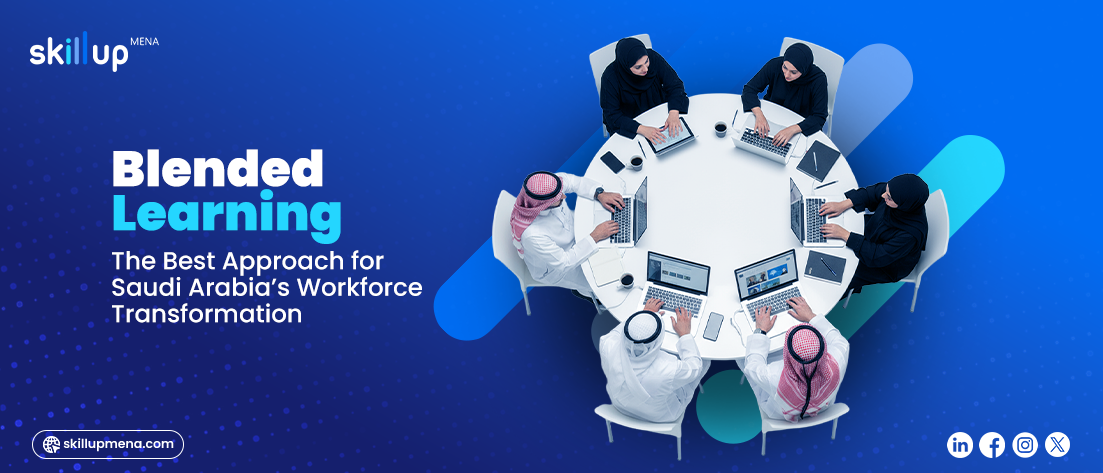Why Blended Learning is Transforming Workforce Development Across MENA — Starting with Saudi Arabia?
As nations pursue ambitious economic diversification goals, with Saudi Arabia’s Vision 2030 leading the charge, organizations face a critical question: How do we upskill our workforce while respecting cultural preferences and maximizing impact?
The answer isn’t choosing between traditional training and digital innovation. It’s simply combining them through blended learning.
The Training Dilemma in MENA’s Corporate Landscape
Across the MENA region, and particularly in Saudi Arabia, organizations are trying to cope with familiar challenges. The corporate learning landscape is dominated by instructor-led workshops where employees travel for 2-3 days to attend certified programs. These sessions carry tremendous credibility and provide valuable networking opportunities, but they’re episodic events that often end when participants return to their offices.
Meanwhile, e-learning platforms promise scalability and flexibility, yet adoption remains inconsistent. Many professionals in the region view online learning as impersonal or lacking the tangible outcomes they expect from training investments. In Saudi Arabia specifically, where face-to-face interactions hold deep cultural significance, purely digital solutions often struggle to gain traction.
This creates a gap: employees need continuous development to thrive in evolving industries, but current training models aren’t designed for sustained impact.
Enter Blended Learning: The Cultural Bridge
Blended learning offers a strategic solution that honors traditional preferences while embracing digital efficiency. By combining the credibility of in-person workshops with the accessibility of online modules, organizations can create learning experiences that resonate culturally and deliver measurable results.
Consider the unique advantages this approach offers across MENA markets:
Geographic Reach: With dispersed teams across major cities — from Riyadh and Jeddah to Dubai, and Cairo — blended models reduce travel costs while maintaining instructor access.
Cultural Sensitivity: The approach preserves the relationship-building aspect of traditional training while gradually introducing digital components as natural extensions rather than replacements.
Language Flexibility: Programs can seamlessly integrate Arabic and English content, reflecting the bilingual reality of modern MENA workforces.
Sustained Engagement: Unlike standalone workshops, blended programs create ongoing learning journeys that reinforce key concepts and build habits over time.
The Saudi Arabian Success Story
Saudi Arabia presents a compelling case study for blended learning implementation. The Kingdom’s rapid transformation under Vision 2030 demands workforce development at unprecedented scale and speed. Organizations are investing heavily in upskilling initiatives, but they need approaches that work within existing cultural frameworks while preparing employees for future challenges.
Smart Saudi companies are discovering that blended learning allows them to:
- Maintain the certification and recognition value that employees expect from training
- Extend learning beyond event-based workshops into continuous development programs
- Scale programs across the Kingdom’s diverse regions without compromising quality
- Balance technical skills training with the soft skills and leadership development Vision 2030 emphasizes
Implementing Blended Learning: A Strategic Roadmap
Successfully launching blended learning in MENA requires thoughtful implementation that respects local contexts while driving modern outcomes.
Start with Trust-Building: Anchor programs with familiar in-person elements; kickoff sessions, certified workshops, or instructor-led components. This builds confidence before introducing digital elements.
Design for Reinforcement: Use online modules to reinforce and expand on workshop content rather than replacing face-to-face interaction entirely. Short, focused digital sessions work better than lengthy e-learning courses.
Localize Meaningfully: Go beyond translation to create content that reflects regional business contexts, case studies, and cultural nuances. Saudi professionals respond to examples from their industries and markets.
Leverage Smart Technology: Modern learning platforms can personalize experiences, track progress, and provide insights that help both learners and L&D teams optimize programs continuously.
Balance Skill Development: Combine technical training with leadership development, emotional intelligence, and other soft skills that Vision 2030 and similar regional initiatives prioritize.
Measuring Impact: The ROI of Blended Approaches
Organizations implementing blended learning across MENA are seeing tangible returns on their training investments:
- Higher Engagement: Learners show increased participation rates when programs combine preferred in-person elements with convenient digital reinforcement
- Better Retention: Knowledge sticks better when reinforced through multiple channels and over extended timeframes
- Cost Efficiency: Reduced travel expenses and more efficient use of trainer time while maintaining program credibility
- Strategic Alignment: Better support for national development goals like Vision 2030 through more comprehensive skill development
The success of blended learning often depends on the underlying technology platform. Modern learning management systems offer AI-powered personalization, mobile accessibility, and analytics that help organizations understand what’s working and what isn’t.
Platforms like Totara TXP are particularly well-suited to blended approaches, offering the flexibility to combine various learning modalities while providing the data insights that L&D teams need to continuously improve their programs.
MENA’s Learning Evolution
The shift toward blended learning represents more than a training methodology change — it’s part of the broader digital transformation sweeping across MENA. As the region positions itself as a global hub for innovation and business, workforce development approaches must evolve to match these ambitions.
Saudi Arabia’s early adoption of blended learning models positions the Kingdom as a regional leader in progressive training approaches. Other MENA markets are watching closely, ready to adapt successful strategies to their own cultural and business contexts.
For organizations considering blended learning, the key is starting strategically rather than perfectly. Begin with pilot programs that combine trusted workshop formats with simple digital reinforcement. Measure engagement and outcomes, and make the needed changes based on learner feedback and business results.
The goal isn’t to revolutionize training overnight but to evolve existing approaches in ways that honor cultural preferences while unlocking the scalability and effectiveness that digital tools provide.
Skillup MENA specializes in designing culturally-aware blended learning solutions for organizations across the region. From content digitization and custom localization to technology integration and ongoing support, we help companies build learning programs that work within local contexts while driving global-standard results.
Ready to explore how blended learning can transform your organization’s training approach? Let’s discuss your specific needs and cultural context.

